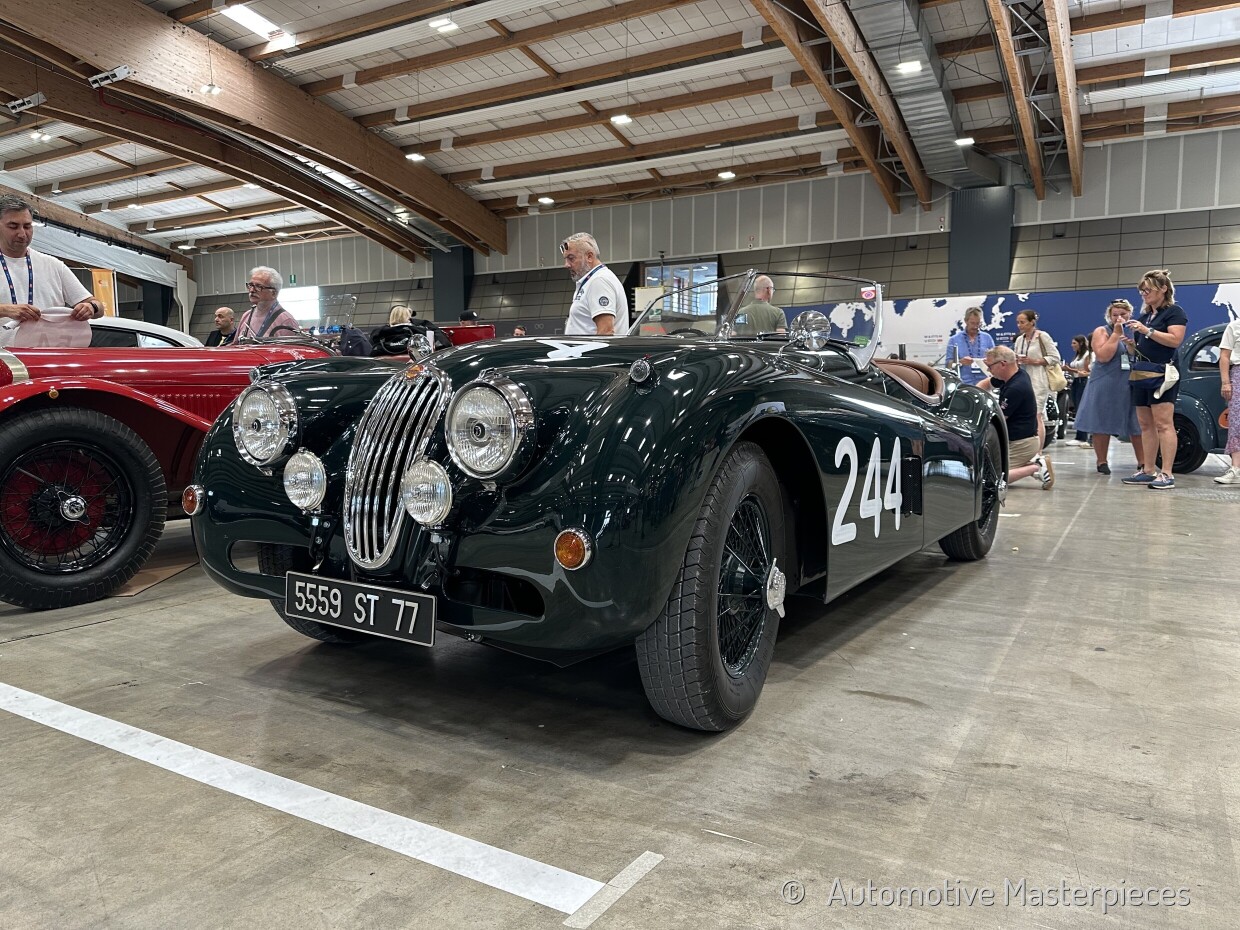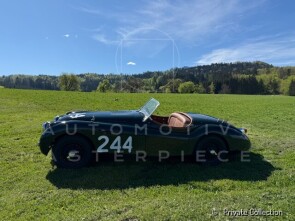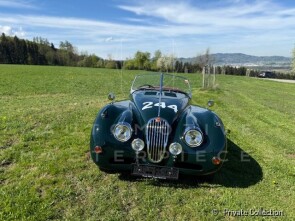
1955 Jaguar XK 140 OTS
ON/OFF
Why am I an Automotive Masterpiece?
H. Works cars
Set up by Jaguar Cars Ltd. (UK)
L. Limited edition cars
no. 3 manufactured, 2nd built. 1 of 3 Jaguar XK140 OTS works set up by Jaguar for the 1956 Mille Miglia
If there is one brand unmistakably linked to the concepts and philosophy of luxury and sports performance, it is Jaguar. The Jaguar XK 140 is a sports car manufactured by Jaguar between 1954 and 1957 as the successor to the XK 120. Upgrades included increased interior space, improved brakes, rack-and-pinion steering, greater suspension travel, and telescopic shock absorbers replacing the older lever-arm design. The XK 140 was introduced in late 1954 and sold as a 1955 model. Exterior changes that distinguished it from the XK 120 included more substantial front and rear bumpers with overriders and flashing turn signals (operated by a switch on the dash) above the front bumper. The grille remained the same size but became a one-piece cast unit with fewer, broader vertical bars. The Jaguar badge was incorporated into the grille surround. A chrome trim strip ran along the center of the bonnet (hood) and boot (trunk) lid. An emblem on the boot lid contained the words "Winner Le Mans 1951–3". The interior was made more comfortable for taller drivers by moving the engine, firewall, and dash forward, providing 3 inches (76 mm) more legroom. The OTS was the sportiest and most essential option, while the DHC and FHC offered greater comfort and practicality. The Drop-Head Coupé (DHC) had a bulky lined canvas top that lowered onto the body behind the seats, a fixed windscreen integral with the body, wind-up side windows, and a small rear seat. It also featured a walnut-veneered dashboard and door cappings. The Fixed Head Coupé (FHC) shared the DHC's interior trim and rear seat. The prototype Fixed-Head Coupé retained the XK 120 Fixed Head roof profile, with the front wings and doors identical to those of the Drophead Coupé. Production cars had the roof lengthened, the windscreen placed further forward, shorter front wings, and longer doors, all of which resulted in easier entry and more interior space and legroom. Two 6-volt batteries, one in each front wing, were fitted to the Fixed-Head Coupé, while the Drop-Head Coupe and the Open Two-Seater had a single 12-volt battery installed in the passenger-side front wing. The XK 140 was powered by the 3.4-litre Jaguar XK inline-six engine, designed by William Heynes, incorporating the Special Equipment modifications from the XK 120. These increased the specified power by 10 bhp to 190 bhp gross at 5,500 rpm as standard. The optional C-Type cylinder head, carried over from the XK 120 catalogue, produced around 210 bhp at 5,750 rpm. When fitted with the C-Type head, 2-inch sand-cast H8 carburetors, heavier torsion bars, and twin exhaust pipes, the car was designated XK 140 SE in the UK and XK 140 MC in North America. In 1956, the XK 140 became the first Jaguar sports car to be offered with automatic transmission. As with the XK 120, wire wheels and dual exhausts were optional, with most XK 140s imported into the United States featuring the optional wheels. Cars with standard disc wheels had spats (fender skirts) over the rear wheel opening. Factory-spec 6.00 × 16-inch cross-ply tires or optional 185VR16 Pirelli Cinturato CA67 radial tires could be fitted on either 16 × 5K½ solid wheels or 16 × 5K (Special Equipment) wire wheels. A stock XK 140 SE could achieve a top speed of 120–125 mph (193–201 km/h). Road & Track's XK-140 MC test in June 1955 recorded a best two-way average of 120.3 mph (193.6 km/h). The best one-way run was 121.1 mph (194.9 km/h). Sports Cars Illustrated's test of the same model in August 1957 recorded its fastest two-way average at 121 mph (195 km/h). Their best one-way run was 124 mph (200 km/h). Karl Ludvigsen's test published in Sports Car World (July 1957) had the same results as the SCI test. Acceleration from 0–60 mph (97 km/h) was recorded at 8.4 seconds, 9.1 seconds, and 9.1 seconds, respectively. Only the R&T test attempted 0–100 mph (161 km/h), which took 26.5 seconds. Standing 1/4-mile (~400 m) times were 16.6 seconds at 82 mph (approximately 132 km/h) and 16.9 seconds at 86 mph (138 km/h). According to the Jaguar Heritage Trust, a total of 3,349 cars were built: 73 in right-hand drive and 3,276 in left-hand drive configuration.
The Roadster (designated OTS - Open Two-Seater) was the sportiest and most essential version of the XK 140. With its lightweight design and open cockpit, it was aimed at driving enthusiasts who valued performance over comfort. The OTS featured a light canvas top that folded completely out of sight behind the seats. The interior was trimmed in leather and leatherette, including the dashboard. Like the XK 120 Roadster, the XK 140 OTS had removable canvas and plastic side curtains on light alloy barchetta-type doors, and a tonneau cover. The door tops and scuttle panel were cut back by two inches (50 mm) compared to the XK 120, improving steering wheel positioning and driver ergonomics. The front face of the doors (A-Post) was redesigned from 45 to 90 degrees, allowing easier entry and exit. The windscreen remained removable, maintaining a pure open-air driving experience. While Jaguar’s XK 120 had already established the brand as a dominant force in motorsport, the XK 140 OTS carried forward this racing pedigree. Although it was not a full-fledged race car, it was frequently used in privateer racing and endurance events, particularly in the United States, where amateur drivers competed in SCCA (Sports Car Club of America) races. The Jaguar XK140 Open Two-Seater (OTS) was produced in 3,347 units between 1954 and 1957.
Jaguar XK 140 OTS with chassis no. S800034DN was built as one of the only three Works Jaguar XK 140s, the other two being S800033DN and S800035DN. Cars with chassis no. 033 and 034 were traditionally painted British Racing Green, while 035 was finished in Cream White, as it was the favorite color of Ian Appleyard, its driver. The trio was equipped with SE specifications and were right-hand drive. Chassis no. S800034DN was delivered new to Paris Jaguar importer “Royal Elysées”, founded by Charles Delacroix, and registered in Paris (74 EH 75). It was sold to M. Jean-Claude George, a chemical engineer and sports car enthusiast. He drove the car at the 1956 Mille Miglia, starting from Brescia with racing number #244. However, while its sister car S800035DN won its class, "Sports cars with a price limit not exceeding Lit. 2,000,000", M. George in S800034DN was forced to withdraw just after Pescara and was unable to reach Rome. There is no further evidence of any additional competitive use of the car, and, unless new discoveries emerge, it is presumed to have been used for leisure purposes afterward. The car was sold by M. George in May 1976 to another engineer, M. Alain Mongaudon, and moved just outside Paris to Les Vergers, one of the 28 hamlets that make up the municipality of Château-Landon, in the Île-de-France region. The car was registered as 5559 ST 77 (Seine-et-Marne department). M. Mongaudon kept the car for 47 years, and in 2023, he sold it to a private collection. The car has been featured in several specialist books and received the Jaguar Heritage Production Record Trace Certificate in 2014 (no. 39625) and 2024 (no. 75520). Since December 2024, it has been registered with an Austrian license plate W 12702 C.





